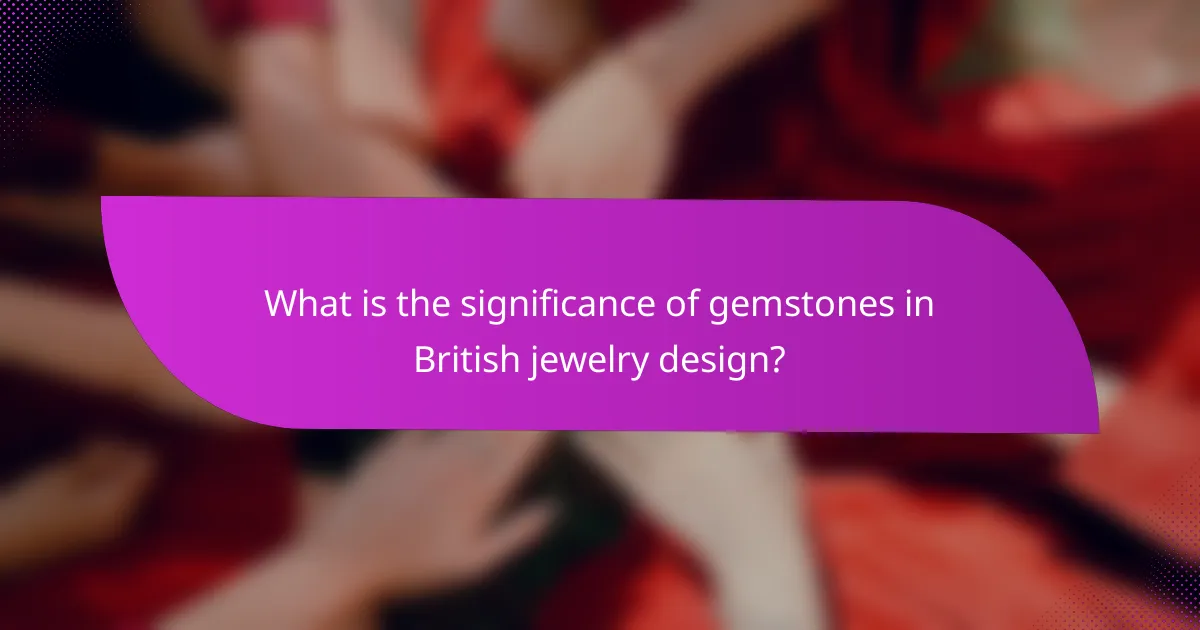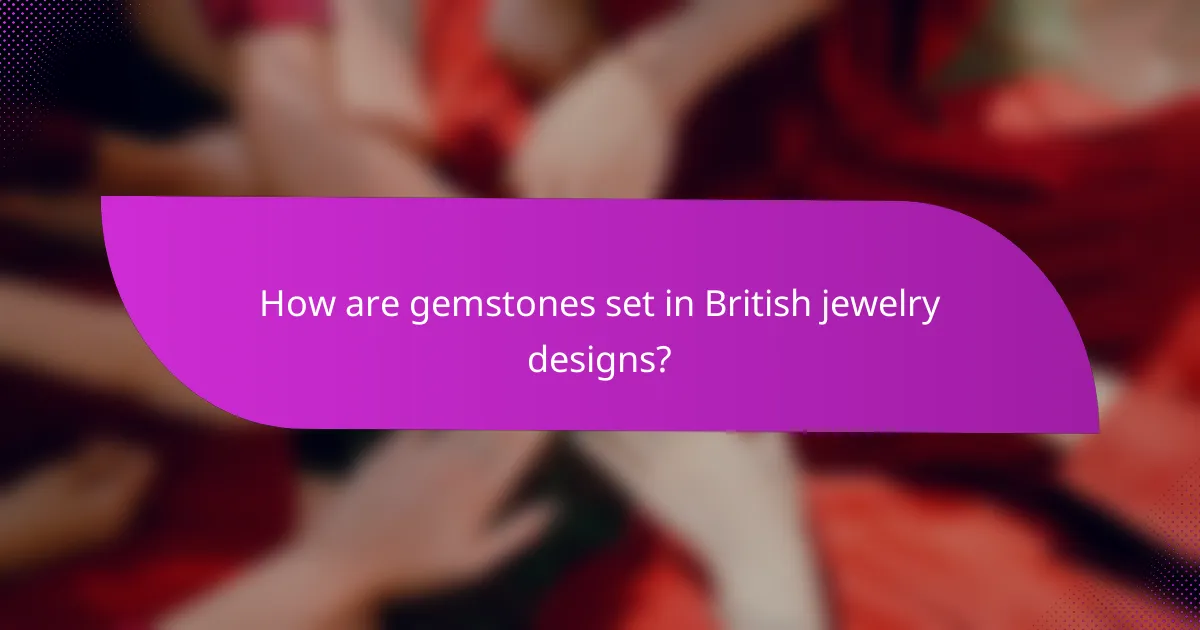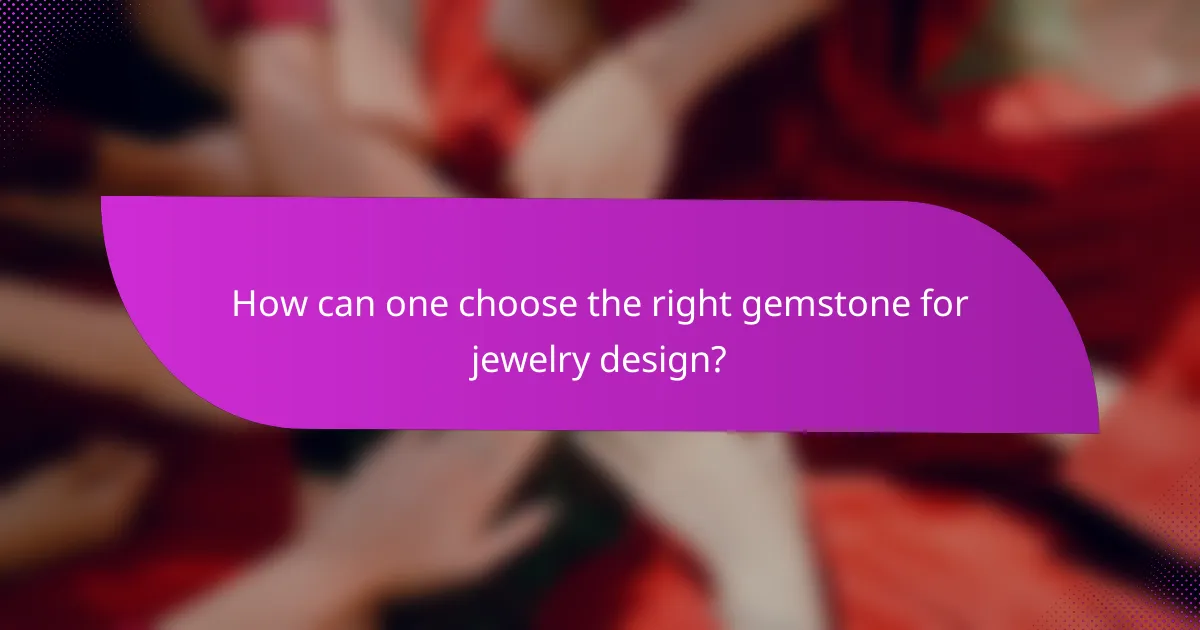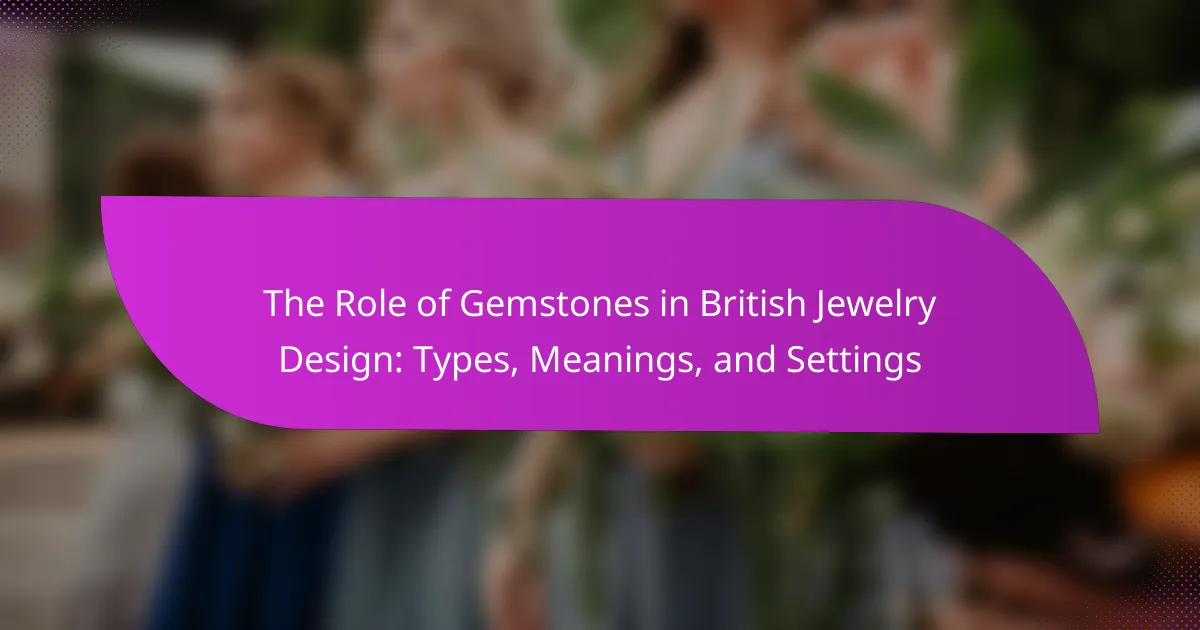Gemstones are essential elements in British jewelry design, enhancing both aesthetic appeal and cultural significance. Historically associated with wealth and status, gemstones like diamonds, sapphires, and emeralds have been integral to royal collections, notably the Crown Jewels. The article explores various gemstone settings, including prong, bezel, and pavé, which ensure both security and visual allure. It also discusses the importance of factors such as color, durability, and symbolism in selecting the right gemstone for jewelry, highlighting how these attributes influence consumer choices in contemporary designs.

What is the significance of gemstones in British jewelry design?
Gemstones hold significant importance in British jewelry design. They enhance the aesthetic appeal of pieces. Historically, gemstones have symbolized wealth and status. British royal families have long used gemstones in their jewelry collections. For instance, the Crown Jewels include diamonds, sapphires, and emeralds. These stones reflect power and heritage. Additionally, gemstones often carry specific meanings, such as love or protection. The use of local stones, like Scottish agate, also showcases national pride. Overall, gemstones are integral to the identity and craftsmanship of British jewelry.
How have gemstones influenced British jewelry aesthetics?
Gemstones have significantly influenced British jewelry aesthetics by dictating styles, colors, and symbolism. Historically, the use of gemstones in British jewelry dates back to the Tudor period. During this time, gemstones like diamonds and pearls became symbols of wealth and power. The Victorian era further popularized colored gemstones, reflecting personal sentiment and social status. Designs often incorporated intricate settings to enhance the beauty of the stones. The Art Deco movement introduced geometric patterns, emphasizing the brilliance of gemstones. Today, British jewelry continues to celebrate gemstones through modern designs while honoring traditional craftsmanship. This evolution showcases the enduring impact of gemstones on British aesthetics.
What historical events shaped the use of gemstones in British jewelry?
The use of gemstones in British jewelry has been shaped by several historical events. The Roman conquest of Britain introduced various gemstones and techniques. The medieval period saw the rise of ecclesiastical jewelry, emphasizing the use of precious stones. The Tudor dynasty popularized the use of diamonds, particularly with the coronation of Elizabeth I. The 19th century brought the Victorian era, which embraced sentimental jewelry featuring gemstones. The discovery of new gemstone sources in colonies expanded the variety available. World War I and II influenced jewelry styles, leading to simpler designs. Each of these events contributed to the evolving significance and application of gemstones in British jewelry.
How do cultural trends impact gemstone choices in jewelry design?
Cultural trends significantly influence gemstone choices in jewelry design. These trends shape consumer preferences and dictate which gemstones are deemed desirable. For example, the rise of eco-consciousness has increased the demand for ethically sourced and lab-grown gemstones. Additionally, cultural events and movements can popularize specific colors or styles, leading to a surge in demand for certain gemstones. Historical contexts also play a role; for instance, the Victorian era emphasized the use of diamonds and pearls, while the Art Deco period favored bold colors like emeralds and sapphires. Social media and celebrity endorsements further amplify these trends, making certain gemstones trendy. Thus, cultural trends are pivotal in guiding the selection of gemstones in contemporary jewelry design.
What are the different types of gemstones used in British jewelry?
Diamonds, sapphires, rubies, and emeralds are commonly used gemstones in British jewelry. Diamonds symbolize strength and purity. Sapphires are valued for their deep blue color and durability. Rubies are associated with passion and love. Emeralds are prized for their vibrant green hue and rarity. Other gemstones include amethyst, topaz, and opal. Each gemstone carries unique meanings and historical significance in British culture. British jewelry often incorporates these stones in various settings, enhancing their beauty and value.
What are the most popular gemstones in British jewelry design?
The most popular gemstones in British jewelry design include diamonds, sapphires, emeralds, and rubies. Diamonds are often favored for their brilliance and durability. Sapphires are prized for their deep blue color and symbolism of wisdom. Emeralds are known for their rich green hue and association with rebirth. Rubies are celebrated for their vibrant red shade and representation of passion. These gemstones are frequently used in engagement rings, necklaces, and earrings. The preference for these stones can be traced back to historical significance and cultural values in Britain.
How do different gemstones compare in terms of rarity and value?
Different gemstones vary significantly in terms of rarity and value. Diamonds are among the most valuable due to their high demand and limited supply. Rubies and emeralds also hold high value but are rarer than diamonds. Sapphires, while valued, are generally less expensive than rubies and emeralds. Rare gemstones like alexandrite and painite are extremely limited in availability, making them highly sought after. The value of a gemstone is often determined by its rarity, size, color, and clarity. For instance, a flawless pink diamond can fetch millions, while common stones like quartz are widely available and much less valuable. The gem market fluctuates, but rarity consistently plays a crucial role in determining value.
What meanings are associated with various gemstones in British culture?
Gemstones in British culture are often associated with specific meanings and symbolism. For example, diamonds symbolize purity and strength. They are commonly used in engagement rings, representing eternal love. Rubies signify passion and courage, often gifted to express deep affection. Sapphires are linked to wisdom and nobility, historically worn by royalty. Emeralds represent rebirth and fertility, frequently used in heirloom pieces. Amethyst is associated with tranquility and balance, valued for its calming properties. Each gemstone carries a unique cultural significance, reflecting values and emotions in British society.
What symbolism do specific gemstones hold in British traditions?
Specific gemstones hold significant symbolism in British traditions. For example, the sapphire symbolizes wisdom and nobility. Historically, it has been associated with royalty and is often used in engagement rings. The diamond represents purity and strength. It is traditionally given as a symbol of enduring love. Emeralds are linked to rebirth and fertility. They are often used in royal jewelry, reflecting wealth and status. Rubies signify passion and courage. In British tradition, they are believed to bring good fortune. Each gemstone’s symbolism is rooted in cultural history and personal beliefs, influencing their use in jewelry design.
How do gemstone meanings influence consumer choices in jewelry?
Gemstone meanings significantly influence consumer choices in jewelry. Consumers often select gemstones based on their symbolic meanings and perceived benefits. For instance, amethyst is associated with calmness and clarity, making it a popular choice for stress relief. Similarly, diamonds symbolize love and commitment, driving their use in engagement rings. Research shows that 70% of consumers consider the meaning of gemstones when making purchases. This connection between gemstone meanings and emotional significance shapes consumer preferences and purchasing decisions.

How are gemstones set in British jewelry designs?
Gemstones in British jewelry designs are typically set using various techniques such as prong, bezel, and pavé settings. Prong settings involve metal claws that hold the gemstone in place, allowing maximum light exposure. Bezel settings encase the gem in a metal rim, providing a secure fit and a sleek look. Pavé settings feature small gemstones set closely together, creating a continuous sparkle on the surface.
These methods ensure that the gemstones are both secure and visually appealing. British jewelers often combine these settings with intricate metalwork, enhancing the overall design. Historical influences, such as Victorian and Art Deco styles, also shape the setting techniques used in contemporary British jewelry.
What are the common settings for gemstones in British jewelry?
Common settings for gemstones in British jewelry include prong, bezel, and pave settings. Prong settings use metal claws to secure the gemstone, allowing maximum light exposure. Bezel settings encircle the stone with metal, providing a secure and modern look. Pave settings feature small gemstones set closely together, creating a sparkling surface. Other settings include channel, which places stones in a groove, and tension, where the gemstone is held in place by pressure. These settings are prevalent in both contemporary and traditional British jewelry designs, reflecting craftsmanship and aesthetic preferences.
How does the choice of setting affect the overall design of the jewelry?
The choice of setting significantly influences the overall design of jewelry. A setting determines how a gemstone is positioned and secured within a piece. Different types of settings, such as prong, bezel, or pave, create distinct aesthetic effects. For example, a prong setting allows more light to enter the gemstone, enhancing its brilliance. Conversely, a bezel setting provides a more modern and secure appearance, often emphasizing the metal surrounding the stone. The choice of setting also impacts the comfort and durability of the jewelry. Additionally, settings can reflect personal style and cultural significance, further shaping the piece’s identity. Therefore, the setting is integral to both the visual appeal and functionality of jewelry designs.
What are the techniques used in gemstone setting?
The techniques used in gemstone setting include prong setting, bezel setting, pave setting, and channel setting. Prong setting involves securing the gemstone with metal claws, allowing maximum light entry. Bezel setting encases the stone in a metal rim, providing durability and a sleek appearance. Pave setting features small stones set closely together, creating a continuous sparkle. Channel setting places stones in a groove between two metal walls, ensuring stability and alignment. Each technique has unique benefits and applications in jewelry design, enhancing the aesthetic and structural integrity of the piece.
What role does craftsmanship play in gemstone settings?
Craftsmanship is essential in gemstone settings as it ensures the secure and aesthetic placement of stones. Skilled artisans create intricate designs that enhance the beauty of each gemstone. The quality of craftsmanship directly affects the durability and longevity of the jewelry piece. Precision in setting prevents damage to the gemstones and maintains their brilliance. Historical craftsmanship techniques, such as hand-setting, have been passed down through generations. These methods contribute to the uniqueness of each piece. High-quality craftsmanship can significantly increase the value of jewelry. In British jewelry design, exceptional craftsmanship reflects cultural heritage and artistic expression.
How do artisans ensure the security of gemstones in their settings?
Artisans ensure the security of gemstones in their settings by using various techniques and materials. They often employ prongs, bezels, or settings that securely hold the gemstone in place. Prongs are small metal claws that grip the stone from multiple angles. Bezels encircle the stone, providing a secure frame. Additionally, artisans may use adhesive compounds to reinforce the setting. They also meticulously inspect each setting for any potential weaknesses. Regular maintenance checks are conducted to ensure the integrity of the gemstone’s placement. This attention to detail minimizes the risk of loss or damage to the gemstones. Overall, these methods are essential for maintaining the beauty and security of jewelry pieces.
What are the challenges faced by jewelers when setting gemstones?
Jewelers face several challenges when setting gemstones. One significant challenge is ensuring the security of the stone. Improper setting can lead to stones becoming loose or falling out. Another challenge is achieving the desired aesthetic. Jewelers must balance the stone’s visibility with the integrity of the setting.
Additionally, different gemstones have varying hardness levels. Softer stones are more prone to scratches and damage during the setting process. Jewelers also deal with the challenge of aligning stones correctly. Misalignment can affect the overall appearance of the piece.
Moreover, some gemstones require specific techniques for setting. For instance, certain stones may need special prongs or bezels. This increases the complexity and time required for the setting process. Lastly, jewelers must consider customer preferences and budgets, which can limit their options. These factors collectively contribute to the challenges faced by jewelers in gemstone setting.

How can one choose the right gemstone for jewelry design?
To choose the right gemstone for jewelry design, consider factors such as color, durability, and symbolism. Color plays a crucial role in the aesthetic appeal of jewelry. Popular choices include sapphires for blue, emeralds for green, and rubies for red. Durability is essential for everyday wear. Gemstones like diamonds and sapphires rank high on the Mohs hardness scale. Symbolism can add meaning to the piece. For instance, birthstones represent personal significance. Research shows that consumers often select gemstones based on these attributes. According to a study by the Gemological Institute of America, understanding gemstone properties enhances design choices.
What factors should be considered when selecting a gemstone?
When selecting a gemstone, consider factors such as type, quality, color, cut, clarity, and carat weight. The type of gemstone determines its rarity and value. Quality includes the stone’s durability and suitability for jewelry. Color affects aesthetic appeal and market demand. The cut influences how light interacts with the stone, enhancing its brilliance. Clarity refers to the presence of inclusions or blemishes, impacting value. Carat weight measures the size, with larger stones typically being more valuable. Understanding these factors ensures a well-informed selection process.
How do personal preferences influence gemstone selection?
Personal preferences significantly influence gemstone selection. Individuals often choose gemstones based on color, clarity, and personal significance. For instance, someone may prefer blue sapphires for their calming effect. Others might select gemstones that symbolize love, like rubies. Cultural background also plays a role in preferences. Certain gemstones may hold specific meanings in different cultures. Personal style influences choices as well; some may favor modern, vibrant stones, while others prefer classic, understated options. Ultimately, personal preferences guide the selection process to ensure the gemstone resonates with the buyer’s identity and values.
What are the best practices for caring for gemstones in jewelry?
To care for gemstones in jewelry, clean them regularly with a soft cloth. Avoid harsh chemicals that can damage the stones. Store gemstones separately to prevent scratching. Use a jewelry box with compartments for organization. Take gemstones to a professional jeweler for repairs or deep cleaning. Remove gemstone jewelry before engaging in activities that may cause damage. Protect gemstones from extreme temperatures and direct sunlight. These practices help maintain the beauty and integrity of gemstones.
What are some tips for incorporating gemstones into modern jewelry designs?
Incorporating gemstones into modern jewelry designs involves selecting the right stones, considering color combinations, and balancing materials. Choose gemstones that complement the overall design concept. Use contrasting colors to create visual interest. Pair gemstones with various metals like gold, silver, or platinum for added elegance. Experiment with different cuts to enhance the gemstone’s brilliance. Incorporate unique settings to showcase the stone’s beauty. Consider the gemstone’s meaning and symbolism to add depth to the design. Use negative space effectively to create a modern aesthetic. Finally, ensure the design remains comfortable and wearable for everyday use.
How can one blend traditional and contemporary styles using gemstones?
To blend traditional and contemporary styles using gemstones, one can combine classic gemstone cuts with modern designs. For instance, using a vintage emerald cut in a minimalist setting creates a striking contrast. Incorporating traditional gemstones like sapphires and rubies in contemporary metalwork enhances visual appeal. Mixing different gemstone shapes, such as round and pear, can add depth to the design. Utilizing innovative techniques like 3D printing allows for unique settings that honor traditional craftsmanship. The juxtaposition of antique and modern aesthetics can create a timeless piece. This approach reflects current trends while respecting historical significance in jewelry design.
What are the current trends in gemstone jewelry design in Britain?
Current trends in gemstone jewelry design in Britain emphasize sustainability and personalization. Designers increasingly use ethically sourced gemstones. This aligns with consumer demand for responsible fashion choices. Vintage and antique styles are also gaining popularity. Many jewelers incorporate unique cuts and settings to enhance individuality. Colorful gemstones are favored over traditional diamonds. This trend reflects a desire for bold expression in jewelry. Customization options allow consumers to create personalized pieces. These trends showcase a shift towards meaningful and distinctive jewelry choices in Britain.
The main entity of the article is gemstones in British jewelry design. The article explores the significance of gemstones, highlighting their historical importance, aesthetic influence, and cultural meanings in British jewelry. It details various types of gemstones commonly used, their associated symbolism, and the techniques employed in gemstone settings. Additionally, the article discusses consumer preferences, trends in modern jewelry design, and best practices for caring for gemstones, providing a comprehensive overview of their role in British jewelry craftsmanship.
